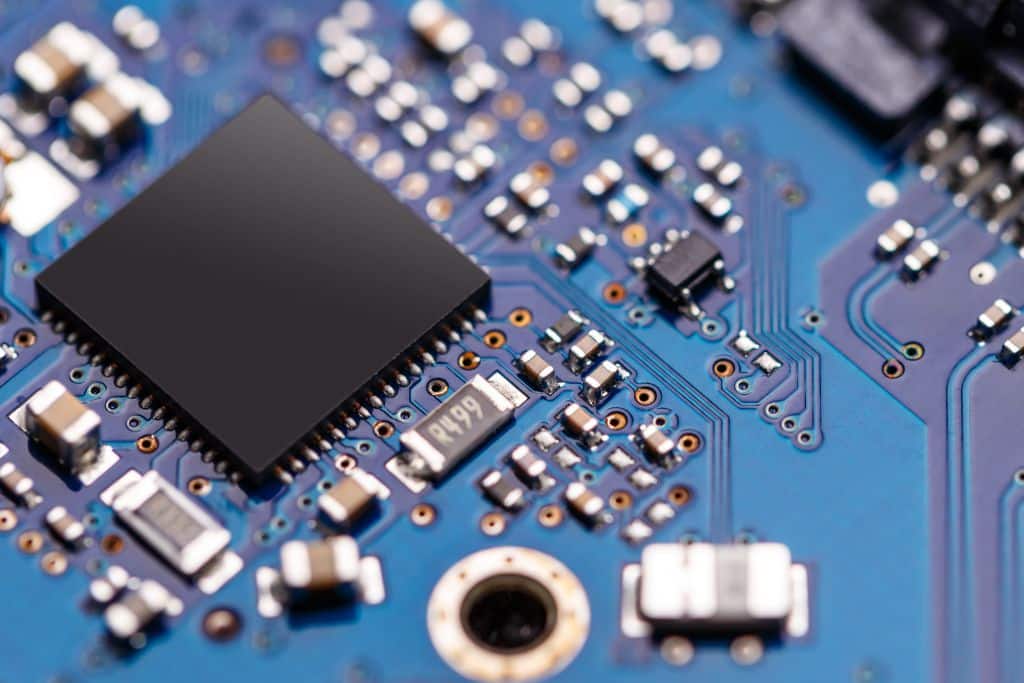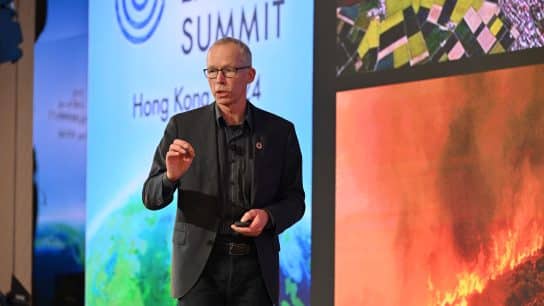In an exclusive interview with Earth.Org, Peter Spiller, a partner at McKinsey & Company and author of a recent report on how to keep the industry on the path to net zero, discusses the importance of semiconductors, the rise in sustainable commitments across the value and supply chains, and the steps needed to keep the industry on track with the Paris Agreement target.
—
The World Meteorological Organization has shown that the past 8 years are on track to be the warmest on record. Emissions of all three main greenhouse gases hit record levels in 2021 and we are again on track to hit record-high emissions in 2022. At COP27 last month, world leaders engaged in heated debates to find the best ways to fulfil the Paris Agreement goal of keeping the average rise in global temperature to 1.5C from pre-industrial levels – though the results were rather upsetting.
All sectors must work extremely hard in the coming years to slash emissions, as this is the only way we might still be able to achieve the 1.5C target. Companies like McKinsey, a global management consulting firm working with clients on their sustainability green goals and decarbonisation and helping them navigate this intricate field, are doing their part in making the transition smoother. However, as the latest IPCC report highlighted, we are quickly running out of time.
The semiconductor industry is undoubtedly among the most important, yet also the most environmentally damaging industries in the world, and, like many other sectors, it is slowly transitioning to more sustainable practices. In an exclusive interview with Peter Spiller, a partner at McKinsey & Company, Earth.Org discussed the present and future of semiconductors and the strives the industry is making to stay on track with the Paris goal.
The Semiconductor Industry
“Pretty much all devices we use in our everyday lives are run on semiconductors,” Spiller explained. Based in Frankfurt, he co-leads McKinsey’s efforts in environmentally-sustainable operations by advising clients across different industries – including the semiconductor industry – on operations transformation. From phones and laptops to heating systems and electric cars, semiconductors power almost everything in our daily lives, and for this reason, they have grown to become indispensable resources worldwide.
In recent years, the world has experienced a global shortage of semiconductors, partly driven by Covid-19 lockdowns and the rising demand for laptops and other devices that suddenly required everyone to work remotely. While the automotive industry was particularly impacted by the shortage, it didn’t take long to realise how much the entire world actually depends on this key resource.
Among the global players are Samsung – the number one semiconductor company in the world – and Intel – the second-largest. Both produce chips for their own products. Taiwanese TSMC, Hynix, and Micron follow. The latter, however, sell their chips to companies across the world.
As Spiller highlighted, three out of the five companies are located in Asia, by far the largest manufacturing market in the world. Most Asian semiconductor companies are spread between Taiwan, South Korea, and Singapore, all places that offer cheap labour costs and are thus preferred over others.
You might also like: The Role of Semiconductors in the Renewable Energy Transition
The Paradox of the Semiconductor Industry
Besides being the building blocks of modern computing, semiconductors are what we need to boost electric vehicles and efficient heating systems, just to name a few examples, meaning they play a key role in facilitating the transition toward greener economies. Paradoxically, however, the environmental cost of manufacturing them is huge.
“Semiconductors have a significant footprint, comparable to the airline industry,” explained Spiller; and given the remarkable growth in demand in recent years, it is not surprising that emissions from the sector have also risen considerably.
As for where emissions come from, Spiller identified three main sources.
“Manufacturing one chip requires one terawatt/hour,” he said. That’s a “massive amount” of energy that inevitably generates high emissions. But besides this, the production process also requires special gases – such as perfluorocarbons – that have about 30 thousand times the global warming potential than CO2. With them also comes chemical waste, which inevitably adds to the already massive environmental footprint. Lastly, chip manufacturing requires very significant water usage, “a key resource for cleaning and cooling”.
Yet, as Spiller put it, the semiconductor industry has a “significant impact downstream”. “We wouldn’t have efficient electric cars without semiconductors that control and make the battery work [and the] same [goes] for energy-efficient heating systems,” he explained.
Is the Industry ‘On Track’?
With such a rapid growth of the semiconductor industry, Spiller explained, there is “no doubt” that the footprint will keep growing. Fortunately, however, emissions associated with the production of single chips are actually going down, owing to progress in sustainable practices and huge investments in decarbonisation practices and water treatment solutions.
In a report published on November 4 titled “Keeping the semiconductor industry on the path to net zero”, Spiller and colleagues at McKinsey focused on investigating and evaluating the industry’s behind-the-scenes practices to understand how companies’ sustainable commitments are shaping it and suggest ways to keep the industry on a 1.5C trajectory.
“Going for net zero is the theme right now,” he explained. “We can definitely see customers reacting and pushing hard. They also have very ambitious targets for decarbonisation and are pushing their suppliers to do the same because they are in their own value chain.”
For example, a company such as Apple could never decarbonise its phones without ensuring that the semiconductor that goes in it is also a zero-emission product.
Despite the promising progress, Spiller said the industry is still “not on track”. In order to get to net zero by 2050, the Intergovernmental Panel on Climate Change (IPCC) is asking for a 42% emission reduction in the semiconductor industry by 2030, equivalent to around 54 million tonnes. However, total emissions account for 93 million tonnes, and in a ‘do-nothing scenario’, the number is expected to double to about 180 million tonnes.
“Emissions would be massive taking into account the growth rate, however, some changes already happening in the manufacturing prevent them to be too high,” Spiller said, adding he still feels “doubtful” that the industry will manage to reach the targets set for 2030 as the gap between current commitments and where the industry needs to be are still “significant”.
Concrete Solutions
Innovation and improvements in recent years led to a range of new technologies that can help bring the semiconductor industry on the path to net zero. Spiller recognises four main steps that could help accelerate sustainable growth and bring the industry’s emissions to 89 million tonnes a year which, despite being quite far away from where we need to be, would still be below where current commitments would lead us.
The first and most obvious driver to decarbonising the industry – considering that about 45% of manufacturing emissions are energy-related – is shifting to renewable electricity. However, as mentioned before, most manufacturers are located on islands, such as Taiwan, South Korea, and Singapore. Here, Spiller explains, it is “virtually impossible” to develop onshore wind power infrastructure. In order to scale up renewables, “the industry needs to come together to find alternative solutions to source renewables from other countries, for example through under-sea cables or hydrogen.”
You might also like: Biggest Taiwan Offshore Wind Farm Generates Its First Power
Another strategy would be to deploy abatement systems, which include burn chambers where gases are burnt and decompose into other gases with less global warming potential. This, however, is still “highly unpopular among manufacturers.” Alternatively, companies can put efforts into recycling gases instead of letting them evaporate.
Lastly, an increasingly viable option would be using alternative gases that have a significantly lower environmental footprint. Despite them being “increasingly available”, many companies are still “very hesitant” when it comes to changing their manufacturing process.
“They don’t want to change running habits as they don’t know how the output will be affected,” Spiller explained. “And yet, this is definitely something worth exploring.”
The Benefits of Collaboration
Spiller repeatedly stressed the importance of collaboration in improving the sector’s sustainability and allowing it to be simultaneously part of the transition to clean energy and net-zero economies, saying that “the transition is already happening.”
No company can become sustainable and reach net-zero alone and the only way of succeeding in this is to work with governments, regulators, and all players across the value and supply chain, including competitors on standard-setting practices.
“Regulatory pressure is kicking in more and more, companies are forced to become “real” about these commitments,” Spiller explained. “There’s also an actual interest from companies to become energy-efficient, partly due to the skyrocketing energy prices, which makes moving to renewable energy a good investment.”
But holding companies accountable isn’t enough. Fundamental incentives that can actually help put companies “on the right track towards decarbonisation” must include cost-reduction opportunities, regulatory policies, tax burden reduction and accountability requirements in terms of progress and transparency. To explain his point, Spiller noted how the European Union Emission Trading Scheme is pushing companies to seriously consider more sustainable practices as their only way of avoiding the hefty taxes imposed by the bloc for their environmentally damaging practices.
Recognising the immense benefits of collaboration, SEMI – the industry association serving the global electronics manufacturing and design supply chain – recently announced the new Semiconductor Climate Consortium (SCC) – a group formed by companies across the semiconductor value chain to accelerate the ecosystem’s reduction of greenhouse gas emissions.
“The SCC is the first global collaborative of semiconductor ecosystem companies focused on reducing greenhouse gas emissions across the value chain,” the official website reads. Members will work together on efforts to align approaches and bring forward technology innovations, ensure transparency and work together towards near- and long-term decarbonisation targets.
Future Outlook
As global demand for semiconductors continues to rise, investing in ways to reduce the industry’s carbon footprint must become a key priority among manufacturers that are working to increase capacity.
Given the progress made in recent years and the growing momentum to find more sustainable technologies, Spiller said he is “confident” that the industry can be fully decarbonised by 2050. However, the road ahead is a “marathon” and only with the right momentum, push from consumers and governments, and serious commitment from companies can we reach this historic goal before it is too late.
You might also like: What Would A Potential Conflict Between China And Taiwan Mean for Global Decarbonisation?


















